ARGENTINA OVERVIEW
From the dense tropical jungles in the north to the frozen landscapes of Antarctica in the south, from the snowy peaks of the Andes in the West, across high plains, Las Pampas, and Patagonia to the Atlantic coast, Argentina is a land of exceptional geographic diversity. It’s also a land of exceptional geographic diversity.
It’s also a land of superlatives. The highest mountain in the western hemisphere, Aconcagua (22,834 ft), towers 4,000 ft above the crest of the Andes. Ushuaia, on the beagle cannel in Tierra del Fuego, is the world’s southernmost city. The continental Ice Cap spreads over 8,400 sq mi in southern Patagonia, descending into glaciers that crash in gigantic chunks from 150-ft walls into the lakes and streams of the Parque National los Glaciares. In the northeast, on the border with Brazil and Paraguay, the Iguazu Falls spill over a horseshoe-shape ledge into a beautiful explosion of 275 waterfalls, varying in height from 140 to 300 ft.
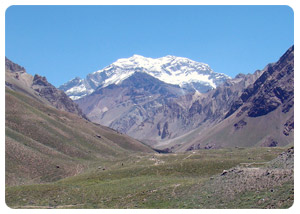 |
 |
World-famous Argentine beef is raised in Las Pampas, the grasslands that cover hundreds of miles in the heart of the country. The topsoil of this alluvial plain is said to be six ft deep, producing grass year round that is so rich that cattle don’t need to be corn fed.
The northwest and the Cuyo possess an astounding diversity of geography, from the barren multiplano to multihued mountains, deserts, deep gorges, and lush valleys with rivers and lakes. Along the south Atlantic coast on the Peninsula Valdés, countless species of marine life cavort on land and in the sea. In January, sea lions breed in rookeries, followed by killer whales, sperm whales, and elephant seals, and from September to March thousands of dignified little Magellanic penguins waddle back and forth on “Penguins highways” from the sea to land in Punta Tombo.
What’s where
Buenos Aires:
The Gateway to all the splendors of Argentina is the sophisticated and Cosmopolitan capital city of Buenos Aires, on the Banks of the Río de la Plata. Here in the Capital Federal, as this sprawling metropolis is known, ten million people (one third the population of Argentina) live in the city’s 46 barrios (neighborhoods), each with its own soccer team and its own identity. A bustling city, Buenos Aires alive with activity, from its vast museums and Paris-like avenues to its late night asados (barbacues) and tango performances.
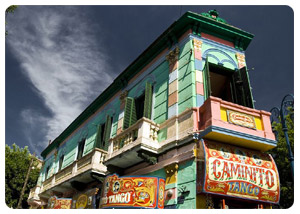 |
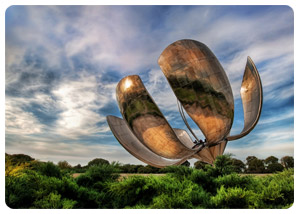 |
Las Pampas:
Sourrounding Buenos Aires, though worlds apart, the flat, expansive grasslands of Las Pampas radiates to the Atlantic Ocean in the east and the mountains to the West. It’s home to the horses and catlle that make up the mainstray of the region’s- and Argentina’s-economy. Signs of active ranch live are everywhere, from the cattle grazing to the gauchos working the wide-open landscapes. Alfalfa, sunflowers, wheat, and corn are also grown here. And along the coast are great beaches, which are the favorite vacation spots for Buenos Aires locals.
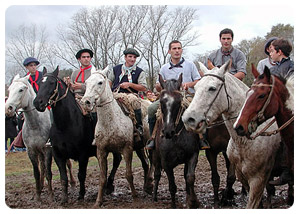 |
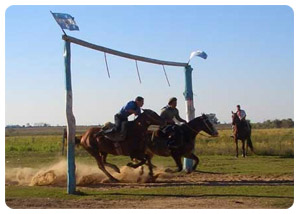 |
Argentina Litoral:
The Argentine Litoral, which encompassed the northeast region of the country, is dominated by two rivers: the Uruguay and The Paraná. Across the Río Paraná to the north lies Paraguay, and across the Río Uruguay to the east are Brazil and Uruguay. The two great rivers finally meet at the southernmost point of the region, right above Buenos Aires, where they form the famous Río de la Plata. The topography of the region varies considerably: Flat, fertile plains extend through the south; laggons and marshlands are found near the center; dry, desolate land covers much of the West; and subtropical forest fills the northeastern corner, also home to the Cataratas del Iguazú, the impressive waterfalls that straddle Argentina and Brazil.
 |
 |
The northwest
The northwest is where Argentine history began, yet few have ventured beyond its cities- Cataarca, Jujuy, Salta, and Tucumán-to its high-mountain passes, deep red gorges, peaceful valleys, and sub-tropical jungles. In thenorthermost province of Jujuy, a polychromatic palette of reds, greens, and yellows washes across the mountain slopes of the Quebrada Humahuaca (Humahuaca Gore) as it follows the Río Grande north. Beyond, the great high plateau of the Puna stretches along the borders with Bolivia and Chile. A mixture of pre- Columbian and Spanish culture is apparent throughout in the architecture, costumes, festivals, music, and handicrafts. In the sunny Calchaquí Valey, between Tucumán and Salta, former colonial Torrontés, (white-wine grape) vineyards, and in the cities, the plazas and churches recall the Spanish influence. Even pre-Inca civilizations have left their marks on ghostly menhirs.
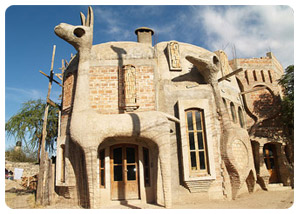 |
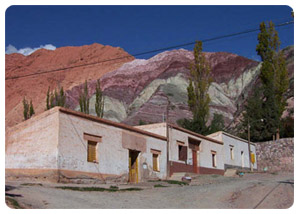 |
The Cuyo
Here you find the great wine-producing provinces of Mendoza and San Juan. North of Mendoza, the slow-paces captital city of San Juan is the birthplace of Argentina’s great educator, wroter, and past president, Domingo Faustino Sarmiento. It’s also the gateway to the curious paleontological treasures of the Valle de la Luna (Valley of the Moon). San Luís Province is home to the giant Parque Nacional las Quijadas. The Pan- American highway passes through Mendoza, heading west over spectacular Uspallata pass to Chile: Along the way are hot springs, Inca ruins, Los Penitentes ski area, and an incomparable view of Aconcagua. Farther south neat the city of San Rafael, you can raft down the Atuel or Diamante rivers, rode horseback over the Andes, or ski at the super resort of Las Leñas near Malargue.
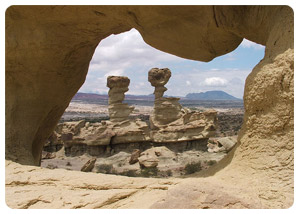 |
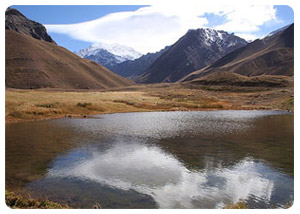 |
Patagonia
Argentine Patagonia extendes 1,920 km (1.200mi) along the spine of the Andes from Río Colorado in the north to Cape Horn- the southernmost land mass on the continent. On the eastern slopes of the Andes, high peaks rise above thousands of lakes, streams, glaciers, waterfalls, and ancient forest –most of them protected within five national parks in the area known as Andean Patagonia, or the Patagonian lake district. Bariloche, San Martín and Esquel all have airports served by major airlines, and there are good bus connections to points in between. The main attraction of the southern lake district is the Parque Nacional los Glaciares near Calafate, and the Fitzroy mountains, which lie 230 km (142 mi) north. It’s possible to link the two lake districts in one long adventures on R40, known as “the lonliest road in the world.”
 |
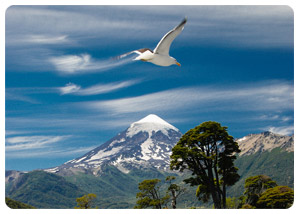 |
FESTIVALS AND SEASONALS EVENTS IN ARGENTINA
Summer:
DECEMBER: Trelew celebrates the Fiesta Provincial del Pingüino (Provincial Festival of the Penguin).
JANUARY: Cosquín is the home of the Festival Nacional del Folklore (National Festival of Folklore), held every January in the Plaza Próspero Molina. At the same time, the town hosts the Festival Provincial de las Artesanias (Provincial Festival of Artistans), during which craftspeople from all over the province come to sell their wares. During the second week in January, Viedma and Carmen de Patagones host the Regata del Rio Negro, a race of boats from around the región.
FEBRUARY: Every year during the second week of February, Camarones, in Patagonia hosts the Fiesta Nacional del Salmon (National Salmon Festival), with festivities and fishing contest.
MARCH: In Viedma and Carmen de Patagones, March 7th begins the anual, weeklong Fiesta de Soberanía y la Tradición, during which towns celebrate their defeat of Brazil in an 1827 incursion, with Music, food, crafts,and cultural exhibits.
Winter:
JUNE: In the Northwest, Inti Raymi (Festival of the sun) is celebrated on June 20, the night before Winter solstice, when the suni s thanked for last year’s harvest. On June 16 and 17, when the Salta Gaucho Parade takes place, hundreds of Gauchos Salteños ride into Salta in full gaucho regalía: big, wide, wrap-around leather chaps (for the thorny bushes that grow in the region), black boots, bombachas (baggy pants), knife tucked into their belts, and their signature red-and-black ponchos. The nation’s best folk artists hold forth in outdoor peñas.
JULY: The Fiesta del Poncho takes Place in Catamarca for a week in July: Artisans from the province exhibit and sell their best weaving, baskets, ceramics, and wood carvings, and folk singers perform in the evening. In Tucumán, Día de Independencia (Indepence Day) is celebrated with much fervor on July 9. In July Bariloche hosts the Fiesta de las Colectividades (Party of Different Communities), a celebration of the town’s diversity, dancing, music, handicrafts, and food from Europe, Scandinavia, the middle East, Central Europe, and South America are represented.
AUGUST: Pachamama (Mother Earth) is celebrated August 1 in Humahuaca, in Jujuy province. On August 22, Jujuy celebrates the semana de Jujuy (Jujuy week) with a reenactment of the great 1812 exodus: Citizens dress in period costumes and ride their horses or carts though town, hotels are usually booked up during this week. The Fiesta Nacional de la Nieve ( National Snow Festival ) is a month-long winter carnival that takes place in August all over Bariloche and at the Catedrál ski area.
Spring:
SEPTEMBER: On September 24, Tucuman celebrates the Battle of Tucumán, commemorating Belgrano’s victory over the Spanish during the war of Independence. One of Trelew’s major cultural events is the Eisteddfod de la Juventud in early September, which celebrates the music, food, and dance of Welsh tradition. During Bariloche’s semana Musical Llao Llao (Llao Llao Musical Week) in September, international soloists and orchestras perform classical, jazz, and tango music at the Hotel Llao Llao.
OCTOBER: Belen de Escobar (Known as the national flower capital) holds a flower exhibition in October. The Festival Nacional de la Cerveza (National Beer Festival, or Oktoberfest) takes place in the town of Villa General Belgrano, which was originally settled by Bavarian and Alsatian immigrants. The second half of October marks Trelew’s Eiseddfod de Chubut, a Welsh literary and musical festival, first held in Patagonia in 1875.
NOVEMBER: Each year in November, San Clemente del Tuyu hosts the Festival of its patron saint, San Clemente Romano. The entire city comes out to see the procession, which ends in a huge asado.
|



